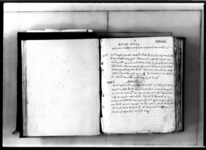A copy of a lālamohara from King Gīrvāṇayuddha appointing Raṇasura Thāpā as caretaker of the guṭhī attached to Śrī Kālī (VS 1866)
ID: RRC_0009_0002
Edited and
translated by Astrid Zotter
in collaboration with
Pabitra Bajracharya
Created: 2022-10-17;
Last modified: 2023-03-01
For the metadata of the document, click here
The accompanying edition, translation/synopsis and/or commentary are available under the terms of the Creative Commons Attribution-ShareAlike 4.0 International License
Abstract
This copy of a lālamohara from the king, who according to the date must have been Gīrvāṇayuddha, appoints Subedāra Raṇasura Thāpā as the caretaker of a Śrī Kālī trust (guṭhī) with landed property at Purakoṭa. He is to ensure that accessories needed for worshipping the goddess are provided as before and is to clear accounts at the royal court annually.Diplomatic edition
[1]
1⟪२३⟪२⟫४नं⟫12पुरकोटसेरोफेरोलगापातस्मेततलाईअखती
3य़ारीगरीवक्स्य़ौंआफ्नाखातीरज्मासंगहिजोदेखि
4गरीआय़ाकोपर्वपर्वमानित्यनैमित्यकताव़ा
5पत्रवमोजिमकोसाराजामदीपुजागराउनुज्मा
6खातिरसालपुग्य़ापछिदर्वारआईज्माखर्च
7कोवहीवुझाउन्य़ागरईतीसम्वत१८६६साल
8मितीपौषवदी१५रोज६सु¯¯¯ ¯¯¯ ¯¯¯ ¯¯¯ ¯¯¯ ¯¯¯ ¯¯¯ ¯¯¯
Translation
[1r]
no. 2341
Āge: To SubedāraRaṇasura Thāpā
We confer2 upon you the post of caretaker (akhtiyārī) for the guṭhī of [Śrī Kālī]3 together with the lands attached to it [in] the surroundings [of] Purakoṭa [in] Tanahu. Conscious of your duties, let the worship be performed—as it has traditionally been performed in yesteryears on the different festival days [both] regular [and] occasional—by supplying the accessories (sarjāma) according to [what was fixed in] the copperplate (tāmāpatra)4 . Whenever a year has passed come to the royal court (darabāra) and dutifully5 have the accounts containing total expenditures cleared.
Friday, the 15th of the dark fortnight of Pauṣa in the [Vikrama era] year 1866 (5 January 1810). Auspiciousness.
Commentary
This royal order, copied in the 9th volume of the Regmi Research Collection, was translated in the Regmi Research Series (Regmi 1974: 133). Being unaware of the larger context of the document, M.C. Regmi mistakenly took the document to refer to the "Guthi (lands) of Sri Kali temple in the Tanahusur area" (ibid.). As can be inferred from related documents, it concerns the guṭhī of Śrī Kālikā worshipped at Gorkha Palace that had been endowed with the administrative subdivision (thuma) Purakoṭa in Tanahun as its landed property by Queen Kāntavatī Devī. For the copperplate recording this endowment, pledged in VS 1856 (1799 CE), and further documents relating to the ensuing guṭhī, see K_0120_0020; for the attendant deed of gift reissued in VS 1942 (1885 CE), see K_0120_0024.
Raṇasura Thāpā, appointed in the present document to ensure the supply of worship material by tapping the guṭhi's revenue, was replaced in VS 1876 (1819 CE) by Tārānātha Arjyāla (K_0015_0022B). It is unknown whether he held the post of caretaker for the complete period of ten years between his appointment and Tārānātha Arjyāla's, or whether the post was held by anyone else in between. In VS 1874 (1817 CE) Raṇasura Thāpā offered a silver necklace to Śrī Kālikā of Gorkha Palace (K_0245_0011).

